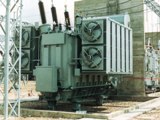Inrush current of the transformer
 When the transformer is connected to the mains, the shock to the full voltage in the transformer can cause a very large inrush current exceeding ten times the magnetizing (no-load) current during normal operation.
When the transformer is connected to the mains, the shock to the full voltage in the transformer can cause a very large inrush current exceeding ten times the magnetizing (no-load) current during normal operation.
Since the magnetizing current in the transformer does not exceed a few percent of the rated current of the transformer, the maximum values of the inrush currents of the magnetizing currents when the transformer is shaken exceed the rated current by no more than 6 — 8 times.
From the point of view of the dynamic stability of the transformer windings, the indicated inrush currents for the transformer are safe, since the winding is designed for a large number of currents that occur in short circuits behind the transformer. The protection of the transformer is adjusted from the aforementioned magnetizing current surges by using suitable devices (saturated intermediate transformers, etc.).
When the coil is switched on at full voltage, surges may occur in the coil due to uneven voltage distribution across the coil and the occurrence of transient waveforms. But the specified overvoltages for the transformer windings are safe, since their insulation is calculated for more significant atmospheric (lightning) overvoltages.
Therefore, the inclusion of all transformers in the network with a push to full voltage is completely safe, it is carried out without preheating the transformer, regardless of the season and the temperature of the transformer oil.
The above also applies to the inclusion of a transformer in the network after installation or overhaul, since experience shows that when it is turned on by pressing and there is a fault, the transformer is disconnected from the protection in time and the amount of damage is no more than when the transformer is turned on by slowly increasing the voltage from zero, which causes significant difficulties in working conditions and is often impossible.
Transformers must be supplied with full voltage on the supply side, where appropriate protection must be installed.
Push-on test at nominal voltage
When switched on 3-5 times, there should be no such phenomena indicating the unsatisfactory condition of the transformer. This experience also confirms the setting of the overcurrent protection in relation to the magnetizing current of the transformer. Physically, the occurrence of overcurrent is explained as follows.When the transformer is turned on, the transient process is the process during which the magnetic flux can be considered as the sum of two components: a periodic one with a constant amplitude and a slowly damped aperiodic one.
At the moment of inclusion, these components are equal in value and opposite in sign, their sum is equal to zero. When the periodic component acquires the same polarity as the aperiodic component, they are added arithmetically. The highest possible value of this sum is nearly twice the amplitude of the periodic component. Due to the deep saturation of the steel of the magnetic circuit, the pressure of the idle current can exceed its value in tens and hundreds of times and 4-6 times the rated current.
